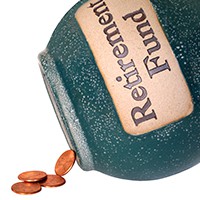Last updated: February 25 2019
Tax Tip: TFSA or RRSP?

Is it better to invest your money into your TFSA or RRSP? The answer here isn’t black and white, so we decided to crunch some numbers and shed some light on the grey areas, for those who need to make the choice in anticipation of the March 1 RRSP contribution deadline.
The TFSA seems to be the winner over time, even in cases where income splitting is available in retirement. But there is a wild card: you need to consider which tax bracket you’ll be in both at the time of RRSP contribution and at  retirement.
retirement.
It’s important to remember that the TFSA must be funded with after-tax dollars. The RRSP creates a tax refund on contribution and so is invested on a pre-tax basis. In both plans, earnings are tax-sheltered while in the plan. Upon withdrawal, all amounts are tax-free from the TFSA; all amounts are taxed if they come from the RRSP.
How does it pan out over a lifecycle? Here’s an example with a single $5,000 deposit. Assume the tax bracket is 25% when the taxpayer starts saving, earning 3% annually on the deposit over time. The taxpayer’s tax brackets gradually increase until the money is withdrawn 40-years later. The results are compared for investments in an RRSP, a non-registered account and a TFSA.
The RRSP comes out ahead of the TFSA when the current MTR (Marginal Tax Rate) is higher at the time of contribution than at retirement. Both tax-preferred investments beat the non-registered account. Note that in the first chart, the RRSP contribution generates a $1,250 tax refund. This refund grows on a tax-sheltered basis to $16,310 vs the $12,232 for the TFSA (which has to be funded with after-tax dollars).
But, along with that RRSP deduction up front, comes an income tax liability at the end of the line of $5,871. The net gain is $10,438.52. The investor matches the TFSA returns when the RRSP benefits are split with a spouse.
| RRSP | MTR | Contribution | Earnings | Balance | Tax Savings | Net |
|---|---|---|---|---|---|---|
| Year | ||||||
| 0 | 25% | $5,000.00 | $ - | $5,000.00 | $1,250.00 | |
| 1 to 10 | 25% | $1,719.58 | $6,719.58 | |||
| 11 to 20 | 32% | $2,310.97 | $9,030.56 | |||
| 21 to 30 | 36% | $3,105.76 | $12,136.31 | |||
| 31 to 40 | 39% | $4,173.88 | $16,310.19 | |||
| End | 36% | -$16,310.19 | $ - | $5,871.67 |
$10,438.52
|
|
| Split | 25% | $16,310.19 | $ - | $4,077.55 | -$12,232.64 | |
| Non-R | MTR | Deposit | Earnings | Tax | Balance | |
| Year | ||||||
| 0 | 25% | $3,750.00 | $ - | $3,750.00 | ||
| 1 to 10 | 25% | $1,289.69 | $322.42 | $4,717.26 | ||
| 11 to 20 | 32% | $1,622.34 | $519.15 | $5,820.46 | ||
| 21 to 30 | 36% | $2,001.75 | $720.63 | $7,101.58 | ||
| 31 to 40 | 39% | $2,442.35 | $952.52 | $8,591.41 | ||
| End | 36% | - $8,591.41 | $ - | $8,591.41 | ||
| TFSA | ||||||
| Non-R | MTR | Deposit | Earnings | Tax | Balance | |
| Year | ||||||
| 0 | 25% | $3,750.00 | $ - | $3,750.00 | ||
| 1 to 10 | 25% | $1,289.69 | $ - | $5,039.69 | ||
| 11 to 20 | 32% | $1,733.23 | $ - | $6,772.92 | ||
| 21 to 30 | 36% | $2,329.32 | $ - | $9,102.23 | ||
| 31 to 40 | 39% | $3,130.41 | $ - | $12,232.64 | ||
| End | 36% | -$12,232.64 | $ - | $12,232.64 |
Non-registered savings alone, come up short because of the tax bite along the way. The best case may be to use the TFSA when the current marginal tax rate is lower than expected in retirement and the RRSP when the current marginal tax rate is higher than the expected tax rate in retirement. However, there are other important considertions.
The RRSP deduction also increases access to refundable and non-refundable tax credits throughout your lifetime and this must be factored in. The biggest effect here is on the Canada Child Benefit. The size of the tax advantage depends on both the number of children and the family net income. The following table shows the additional savings generated by an RRSP contribution (because they would increase the taxpayer’s CCB.)
Additional savings (%) generated by lower reductions in the Canada Child Benefit
| Number of Children | $31,120 to $67,426 | Over $67,426 |
|---|---|---|
| 1 | 7% | 3.2% |
| 2 | 13.5% | 5.7% |
| 3 | 19% | 8% |
| 4+ | 23% | 9.5% |
This reduction of lucrative refundable tax benefits effectively increases the marginal tax rate by up to 23% thereby increasing the overall tax benefits received by making an RRSP contribution.
Another big winner is the recipient of Employment Benefits whose net income is over $64,625 ($66,375 in 2019), who potentially avoids a 30% clawback of EI benefits by making an RRSP contribution to reduce that net income below the clawback zone.
High income seniors also have some advanced planning to do. RRSP withdrawals may trigger the OAS Recovery Tax (clawback) for taxpayers over age 65, adding the equivalent of an additional 15% tax on the withdrawal amounts. If the OAS clawback cannot be avoided, the additional cost would make the TFSA contributions more attractive. There are lots of alternatives in planning retirement income, which is the subject of a great certificate course from Knowledge Bureau: Tax Efficient Retirement Income Planning. It includes a sophisticated 20 year retirement calculator, and is this week’s Knowledge Bureau Report featured course.
It’s your money - your life. It’s integral that you take the time to crunch the numbers for a better handle on your investment options before the end of the month and leverage your savings opportunities to get the best after-tax results over the long term.
So what’s the right answer? Perhaps you should do both, and contribute to your RRSP to get the tax savings now together with the most from income-tested refundable tax credits and social benefits available to your family. Then contribute what you save in taxes and benefits to your TFSA for each adult in the family who is a resident of Canada to construct a tax free retirement in the future.
Evelyn Jacks is president of Knowledge Bureau and the author of 54 books on tax and personal wealth management. Her newest book, Defusing the Family Business Time Bomb is available now. Follow Evelyn on Twitter at @EvelynJacks. Walter Harder is a Master Instructor with Knowledge Bureau.
Additional educational resources: Help your clients, or help yourself generate tax-efficient retirement income by taking the MFA™ – Retirement & Succession Services Specialist Program or the newly revised RWM™ Certification Program.
COPYRIGHT OWNED BY KNOWLEDGE BUREAU INC., 2019.
UNAUTHORIZED REPRODUCTION, IN WHOLE OR IN PART, IS PROHIBITED.





